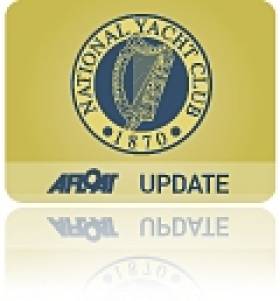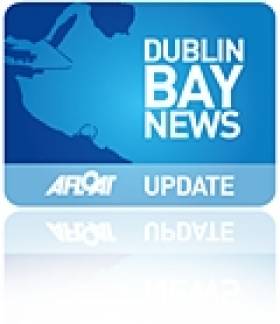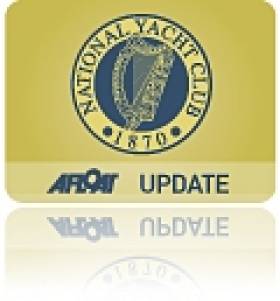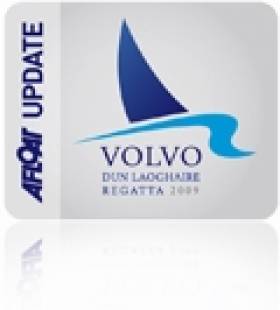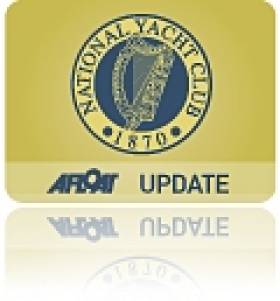Displaying items by tag: nyc
'Skylark' Brings A Touch Of Jazz To the NYC
#NYC - Here's something a little different from the National Yacht Club in Dun Laoghaire: an evening of jazz in the company of Carmel McCreagh and her band on Thursday 17 October.
Described as having a "mellow and velvety" voice, McCreagh will be performing standards from the Great American Songbook such as 'The Days of Wine and Roses' and 'Come Rain or Come Shine', just two of the songs by Jimmy Mercer she recorded for her new album Skylark.
Tickets are just €10 per person available from the yacht club. For more see the NYC website here.
MOD 70 Fleet Just 500 Miles from Dun Laoghaire But Facing Light Headwinds
The leader of the MOD 70s is 500 miles from Dun Laoghaire after passing the half way point on the 1238 miles stage from Kiel to Dublin this afternoon. The five boat fleet remains very closely matched, all making very similar speeds – around 10-12 knots of boat speed.
As they close the final 50 or so miles to the bottleneck that is formed by the Strait of Dover, the busiest shipping lanes in the world, the 70 foot trimaran fleet on Leg 1 of the MOD70 European Tour has continued to move well considering they have headwinds of less than 10 knots, but they will likely slow down even more before they can escape the worst of the small high pressure cell which is effectively guarding the entrance to the English Channel.
After passing the half way point on the 1238 miles stage from Kiel to Dublin, the fleet remains very closely matched, all making very similar speeds – around 10-12 knots of boat speed.
Winds may be light but the pressure remains very intense on this second full afternoon at sea. Knowing that whichever crew can break through the barrier of light winds first and escape into the channel might gain the decisive advantage. Once through the light winds zone the leaders will break into a progressively building breeze from the N'ly quadrant. Accelerating faster and faster, with the prospect of completing the Dover to Land's End passage in some 12-14 hours, the key tactic this Tuesday afternoon is not to be left behind in the Strait.
Brian Thompson from Musandam-Oman Sail reported this morning: "Everyone is concentrating on getting the best speed out of the boat, and we can see that today is a critical day as the wind is going to fall sharply near the Thames Estuary and the fleet is likely to compress. Who gets out of the light patch first may have a lead till approaching Ireland.".
And the fleet remains very closely matched: "We saw Groupe Edmond de Rothschild in the morning yesterday; and although we went entirely different routes all day, and were up to 50 miles apart, we saw them again in the evening! This morning we can see them about 6 miles away - exciting racing." Continued Thompson.
Seeking a chance of additional thermal sea-breeze activity closer to the coast is one possible strategy, but conversely those erring too close to the high land may also lose out when the breeze blows from the forecasted more offshore direction.
Spindrift racing, the leaders since the first night of racing, continued to hold a delta of about five miles on second place, but Sebastien Josse's Groupe Edmond de Rothschild has made a good inroad into FONCIA during the late morning and afternoon and were less than half a mile behind Michel Desjoyeaux's crew.
Having proven a thorn in the side for the FONCIA crew in last month's KRYS OCEAN RACE, it will have been a source of some bemusement to again see Groupe Edmond de Rothschild's dark blue pattern sails looming ever larger from the horizon today.
Guichard and crew on Spindrift racing have split closer to the English coast mid afternoon, diverging temporarily away from the second and third placed MOD70's engaged in a Pas de Deux in the final reaches of the Pas du Calais. But with just 23 miles between first and fifth placed Race for Water, the fleet remains tightly grouped.
Ravussin's Race for Water struggled with an electronics problem, which has meant they were initially unable to get and use high-resolution weather information. This compounded their initial errors, struggling with a bad sail change during the first late evening. But from being more than 70 miles behind, Ravussin, Cammas, Coville and Co have kept chipping away and are now very much in touch with the leaders and passed Musandam-Oman Sail to steal fourth. "We have sailed less than our rivals and so it does not come so easily, but we are getting there." Reassured Ravussin when contacted at midday.
Standings at 12h45 UTC 4th September
1- Spindrift racing (Yann Guichard) at 504,4 miles from Dun Laoghaire
2- FONCIA (Michel Desjoyeaux) at 7,1 miles from leader
3- Groupe Edmond de Rothschild (Sébastien Josse) at 7,4 miles from leader
4- Race for Water (Stève Ravussin) at 14,1 miles from leader
5- Musandam-Oman Sail (Sidney Gavignet) à 16 miles du leader
Sailors Welcomed to NYC for Irish Laser Nationals
#LASER - The Irish Laser National Championships begin today in Dun Laoghaire running till Sunday 26 August, and the National Yacht Club has posted all the details Laser sailors will need regarding their visit for the weekend's competition.
Aside from the parking and event info are the all-important social arrangements for competing sailors, kicking off with a welcome barbecue after today's racing with a selection of burgers, spit roast and chicken. Tickets are €10 and available at registration.
Tomorrow will see the NYC AGM at 5pm after the racing in the JB Room, followed at 6.30pm with a special reception for Laser Radial Olympian Annalise Murphy - not to mention soup and rolls for the hungry sailors after their day on the water.
On Saturday the fleet will be treated to a pasta dish coming off the water, followed by a Tall Ships farewell evening in the Docklands. And Sunday's post-competition activities include the prizegiving ceremony and a farewell barbecue.
Full details for Laser sailors are available on the National Yacht Club website HERE.
#NYC – Howth visitor Darragh Sheridan sailing 'Dinghy Supplies' was a clear winner of the SB20 sportsboat division with two wins in Saturday's National Yacht Club Regatta. ALL CLASSES RESULTS DOWMLOADABLE BELOW.
Fifteen gusting to 25–knot south–westerlies ensured few complaints from any of the sailors with a full programme of races for 20 cruiser, keelboat and dinghy classes.
Sheridan topped a 13-boat fleet with Royal St. George boats taking second and third. Barry O'Neill's Sin Bin was second and David Barry and John O'Driscoll shared third, both on 11 points.
In the Dragon class there was a similar result when Royal St. George boats shared the top prizes. David Williams sailing Phantom beat Edinburgh Cup winner Martin Byrne for regatta honours. In a seven boat fleet there was a three way ties for tie for third place between Denis Bergin, Michael Doorly and Michael Halpenny all on eight points.
NYC regatta results available to download as word docs below.
T.D.’s to Strut their Stuff in aid of Maritime Museum
The fundraiser event which is in aid of the Development Fund of the museum, is to take place this Thursday evening (8 p.m.) on 10th November, in the National Yacht Club (NYC) along the waterfront of Dun Laoghaire Harbour, close to the East Pier.
Tickets costing €20 are available from the Maritime Institute of Ireland's (M.I.I.) museum office located on the top floor of the Dun Laoghaire Shopping Centre, in local fashion shops and by contacting (01) 214 3964.
At the end of last month, the M.I.I. celebrated its 70th anniversary which was founded in 1941. To read more about the museum which is undergoing renovation and due to re-open in March 2012 click HERE and to read other news and developments visit www.mariner.ie
- National Yacht Club
- Dublin Bay News
- Maritime Institute of Ireland
- Dun Laoghaire Harbour
- M.I.I.
- Richard Boyd Barrett
- nyc
- Dun Laoghaire Harbour News
- National Maritime Museum
- East Pier Dun Laoghaire
- Irish Maritime Museum's
- Independent T.D's
- Luke 'Ming' Flanagan
- Mick Wallace
- Captain Roger's
- Irish T.D's
- Dun Laoghaire Shopping Centre
- Dun Laoghaire Waterfont
- Dublin Bay yacht clubs
French Naval Vessel Escorts 'Figaro' Fleet to Dun Laoghaire
To celebrate the stopover of the four-stage 1,695 nautical mile (3,390 km) race, Dun Laoghaire Rathdown County Council, Dun Laoghaire Harbour Company and the National Yacht Club have joined forces to create the Festival des Bateaux (12-14 Aug).
A festival highlight will be a fireworks display which be held on Friday night at 10pm on the East Pier. In addition during the three-day festival programme includes live bands, street entertainment and a market on the Carlisle Pier. For more details and times of the free event go to www.dlrevents.ie
Visitors to the East Pier can take a closer view of the PSP Cormoran from the quayside where the 23 knot offshore patrol vessel (OPV) will be berthed. The Flamant class (OPV) entered service in 1997 after completion by Constructions Mécaniques de Normandie, Cherbourg, where the 477 tonnes vessel is based.
The 54m/177-ft vessel has two 12.7mm machine guns and is used for fishery monitoring, SAR and patrolling France's Exclusive Economic Zone out to 200 nautical miles / 370 km. In addition she is equipped with a high speed RIB-craft that can be deployed from an internal dock-well at the stern.
Irish Sea Events Offer Entry Discounts
"The way this works is that the Clyde Cruising Club are offering a 25% rebate for boats from the 4 Dun Laoghaire Clubs (DMYC, NYC, RIYC, RStGYC) that enter the Brewin Dolphin Scottish series before the expiration of the early bird discount period which expires on April 22nd explained Dun Laoghaire event secretary, Ciara Dowling.
As a reciprocal arrangement the committee of the Volvo Dun Laoghaire Regatta are offering a discount of 50% from the full entry fee to all boats that enter both regattas. To avail of this, boats must register for the early bird entry fee in the Volvo Dun Laoghaire Regatta prior to 2 May 2011. Note the 50% discount will be applied to the full entry fee rate and not the early bird rate.
To avail of this arrangement for the Scottish Series contact the Brewin Dolphin Scottish Series office for details, [email protected] 0044141 221 2774.
To avail of this arrangement for the Volvo Dun Laoghaire regatta visit the event website at www.dlregatta.org or email [email protected]
The Scottish Series takes place from 27–30 May and the Dun Laoghaire regatta from July 7th–10th 2011.
In a further boost for Dun Laoghaire sailors heading north the feeder race from Bangor to Tarbert has been re-instated.
Troon and Largs Marinas are offering competitors berthing rate discounts around Scottish Series.
Competitors from Scotland coming to Dun Laoghaire are reminded that the entry fee to the regatta includes free berthing for the duration of the event.
The official Notice of Race and Online Entry are now available at www.dlregatta.org
National YC Recruits New Club Manager
In a message to members this week Commodore Peter Ryan said Conneely 'has been a huge part of the Club for 21 years and it will be a difficult task to find a replacement of his quality and commitment'.
The newspaper advertisement says the successful candidate 'will have a strong hands on approach to managing a tight knit, highly motivated team of professionals'.
Applicants are requested to email [email protected] before March 1st.


























